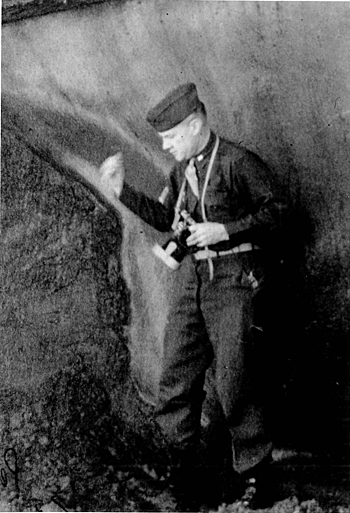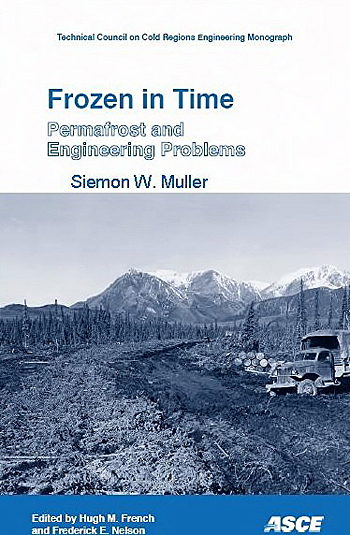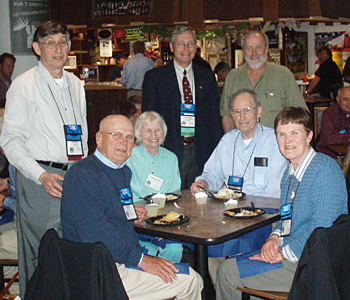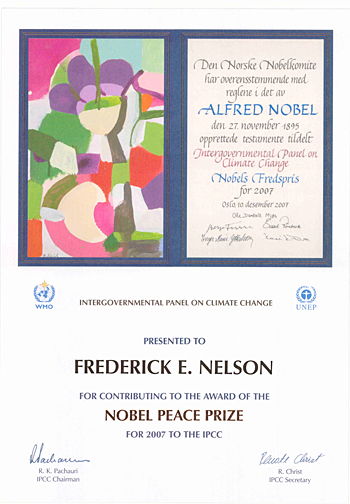
One of the most unusual features of Muller's scientific career is that his final publication first appeared in print nearly four decades after his death. The book, a comprehensive review of permafrost science and engineering, was edited and brought to publication by two permafrost researchers affiliated with the University of Delaware.
Born in Russia, Muller was a cadet in the Imperial Russian Navy in Vladivostok at the time of the 1917 Bolshevik revolution. Escaping this precarious position, he made his way from Siberia to Shanghai. From there, he worked as a purser on a U.S.-bound ship, studied Earth science at several West Coast colleges and eventually became a professor at Stanford University. World War II intervened, and Muller, through the U.S. Geological Survey, was called upon to help with construction of the Alcan Highway (now known as the Alaska Highway), which was built because of the urgent wartime need for an overland route to transport personnel and supplies to Alaska.
Thawing permafrost created many problems for those constructing the road. Muller's contribution took the form of a book, Permafrost or Permanently Frozen Ground and Related Engineering Problems, which summarized Russian-language literature on frozen ground. It was published as a classified document in 1943. During the rest of WWII Muller conducted field studies at military air bases in Alaska and along the Alcan Highway, later receiving the Freedom Medal for his permafrost work.

After the war, Muller returned to his interests in paleontology and stratigraphy, but when his wartime report on permafrost was declassified and published in 1947 it had a tremendous impact on North American permafrost science. It is still cited frequently in the permafrost literature.
Unknown to virtually everyone, however, Muller was working on a comprehensive synthesis of the Soviet and North American permafrost literature during the late 1950s and early 1960s. The manuscript was discovered several years ago in some unopened boxes belonging to the Stanford University professor, who died unexpectedly in 1970. The “new” manuscript's latest references date from 1963, indicating that Muller stopped working on it about that time.With his Canadian colleague Hugh M. French, UD geography professor Frederick (Fritz) Nelson undertook editing and completion of the “lost manuscript.” After considerable searching, French and Nelson also tracked down Siemon Muller's son, Eric Muller, who volunteered to write a dedication for the book.
The result is Frozen in Time: Permafrost and Engineering Problems, a 300-page book published by the American Society of Civil Engineers. The book's July 2008 publication date was chosen to coincide with the Ninth International Conference on Permafrost (NICOP) in Fairbanks, Alaska. Its appearance was announced formally in a NICOP ceremony that also featured a talk by Eric Muller about his father's achievements.

“We view the book as an historic document, so we did virtually no topical updating. We made corrections, reorganized the material and edited the text using a 1950s style manual, so that Muller's writing remains intact,” Nelson said. To give the book historical context they also wrote a lengthy interpretive introduction.
French and Nelson's introduction notes that serendipity played a large role in Muller's contributions to permafrost science, and that he was the “right man in the right place at the right time” for solving permafrost-related problems along the Alcan Highway in the early 1940s. He was a field geologist, broadly knowledgeable about the Earth sciences, and a native speaker of Russian, a big plus because the Soviets had gathered most of the scientific information about permafrost in existence at that time.Why Muller did not publish the 1963 manuscript is a mystery, according to Nelson, who says that Muller was ahead of his time and that much of the material is relevant today. The book also provides an excellent basis for comparing the state of permafrost studies in North America and the Soviet Union 50 years ago and is already being used by historians of science. Publication of the report by a prestigious academic society, nearly half a century after it was written, confirms the book's worth and honors Muller as one of the pioneers of North American permafrost science.

Nelson, a graduate of Northern Michigan University, received his master's degree from Michigan State and his doctorate from the University of Michigan. He has been a professor of geography at UD since 1997 and is co-director of the University of Delaware Permafrost Group. French, who is professor emeritus of geography and a former dean of sciences at the University of Ottawa, currently holds a UD courtesy appointment as research associate, through the Department of Geography.
French and Nelson are, respectively, past presidents of the International Permafrost Association and the U.S. Permafrost Association. Both scientists work closely with UD graduate students on research problems involving traces of ice-age permafrost in the Mid-Atlantic region of the U.S.
Nelson also is a member of the Intergovernmental Panel on Climate Change (IPCC), which was awarded the 2007 Nobel Peace Prize jointly with former U.S. Vice President Al Gore. Nelson recently was issued an official copy of the Nobel award certificate, with an addendum acknowledging his role in the IPCC.
Nelson and UD research associate Nikolay Shiklomanov direct the Circumpolar Active Layer Monitoring (CALM) program, which oversees 168 permafrost observatories in both polar regions. Nelson also co-chaired a task force on the impacts of climate change on permafrost and civil infrastructure for the U.S. Arctic Research Commission.
Nelson conceived and co-chairs UD's William S. Carlson International Polar Year Events, a series of public lectures, receptions, research seminars, art exhibits and film screenings, designed to increase public awareness about the world's polar regions.
Article by Sue Moncure

